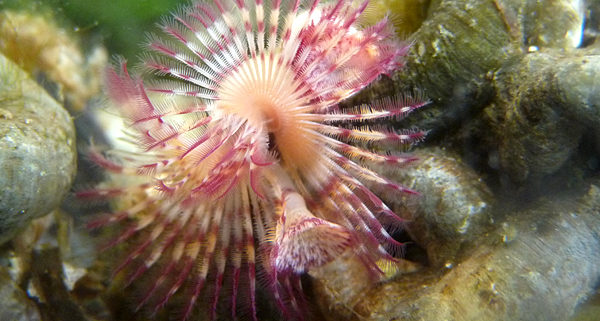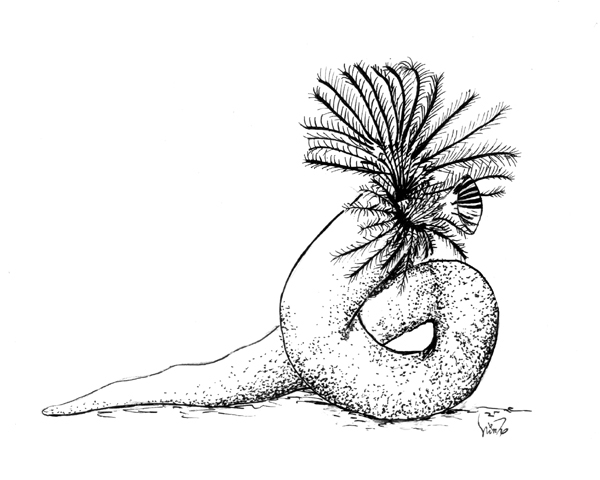Calcareous Tube Worm By Ninh Khuong Common name: Calcareous Tube Worm, Red-Trumpet Calcareous Tube Worm, Limy Tube Worm, Colourful Calcareous Tube Worm. Scientific name: Serpula columbiana In the past the species found on the Pacific Coast of North America was referred to as Serpula vermicularis. They have since been found to be taxonomically distinct from this species and are now referred to as Serpula columbiana. Size range: 2 or 3 inches (5-8 cm) long, tubes up to 4 inches (10 cm) long. Identifying features: Calcareous tube worms have bright colors varying from orange to red with white bands. The most indicative feature of these organisms is their feathery flower-like crown arranged in two spiraled-semicircles. The crown consists of branched tentacles known as cirri or radioles and a trumpet-shaped operculum. The tentacles reorganize into a funnel-shaped stopper when the crown is withdrawn. The animal lives in white calcified tubes. These tubes can be up to 10 cm long and about 2mm in diameter. Coils of white tubes are often seen fastened to hard substrates. Habitat: This species commonly attaches to rocks, shells, floats, piers, stones, and algae such as Fucus.They live in tide pools and low intertidal zone to 100 m (330 feet) deep. These worms tend to stay away from Nereocystis luetkeana, a type of kelp. These kelps contain carbon monoxide in their pneumatocysts, which is highly toxic to Serpula columbiana. The organism can be found in various places from Alaska to Northern California. They are also seen in South and West of Britain, West of Scotland, Pacific, Atlantic, and Indian Oceans. Food: Members of Serpula columbiana are filter feeders that feed on tiny microscopic organisms and detrital particles. When feeding, the animal extends the radioles from the anterior of its tube. Chains of cilia on these tentacles drift food particles towards the mouth. Predators: Some of Serpula columbiana’s predators are the wrasse Ctenolabrus rupestris and Crenilabrus melops, the sea stars Asterias arbens and Pisaster ochraceus, and the urchins E. esculentus and P. miliaris. When the worm is threatened, it reacts instantly by withdrawing into its tube and closing its entrance-way with its operculum. Life cycle: Serpula columbiana has separate sexes and goes through long breeding season occurring in summer. The operculum functions as a brood pouch in the species’ reproduction. Its reproduction includes a larval swimming phase. When removed from tubes, the animal releases gametes that develop into a trochophore larva. Prototroch, metatroch and other structures of the larva are visible after one week. A long apical tuft and a stomach are seen three days later. After two weeks, the larva has left and right ocelli (simple eyes) and chaetae (bristle made of chitin). After four weeks, the head grows farther from the body, and the ocelli move closer to each other. In addition, radiole buds of the larvae are developed. The radiole buds will eventually become adult feeding structures and respiratory organs. As larvae develop into juveniles, they will choose a location to settle. Photograph by Ninh Khuong and D. Young Illustration by Ninh Khuong Video by Ninh Khuong and D. Young
References Dave Cowles. 2006. Serpula vermicularis Linnaeus, 1767. Walla Walla University. Retrieved May 29, 2011 fromhttp://www.wallawalla.edu/academics/departments/biology/rosario/inverts/Annelida/Serpulidae/Serpula_vermicularis.html Fish, J.D. and Fish, S. 2011. A Student’s Guide to the Seashore. Cambridge University Press. Harvey-Clark, Chris. 1997. Eastern Tidepool and Reef: North-Central Atlantic Marine life Guide. Hancock House Publishers. Keay, June. 2011. Larval Development of the polychaete annelid, Serpula vermicularis. University of Oregon. Retrieved May 29, 2011 fromhttps://scholarsbank.uoregon.edu/xmlui/bitstream/handle/1794/5336/Embryology006.pdf?sequence=1 Kozloff, Eugene N. 1983. Seashore Life of the Northern Pacific Coast: An Illustrated Guide to Northern California, Oregon, Washington, and British Columbia. University of Washington Press. Lamb, Andy and Hanby, Bernard. 2005. Marine Life of the Pacific Northwest: A Photographic Encyclopedia of Invertebrates, Seaweeds and Selected Fishes. Harbour Publishing. Lincoln, Roger and Sheals, J. Gordon. 1979. Invertebrate Animals: Collection and Preservation. British Museum (Natural History) Cambridge University Press. McLachlan, Dan and Ayres, Jak. 1996. Fieldbook of Pacific Northwest Sea Creatures. Naturegraph Publishers. Ricketts, Edward and Jack, Calvin. 1992. Between Pacific Tides. Stanford University Press. Sept, J. Duane. 1999. The Beachcomber’s Guide to Seashore Life in the Pacific Northwest. Harbour Publishing. UK Marine SACs Project. 1996. Serpula vermicularis . UK Marine Special Area of Conservations. Retrieved May 29, 2011 from http://www.ukmarinesac.org.uk/communities/biogenic-reefs/br4_5.htm
Interesting resources for research and photographer credit
Latest Projects
VicHigh Marine
Victoria High School
1260 Grant St.
Victoria. BC, Canada
V8T 1C2
Phone: 250-388-5456
Email: dsyoung@sd61.bc.ca






Leave a Reply
Want to join the discussion?Feel free to contribute!